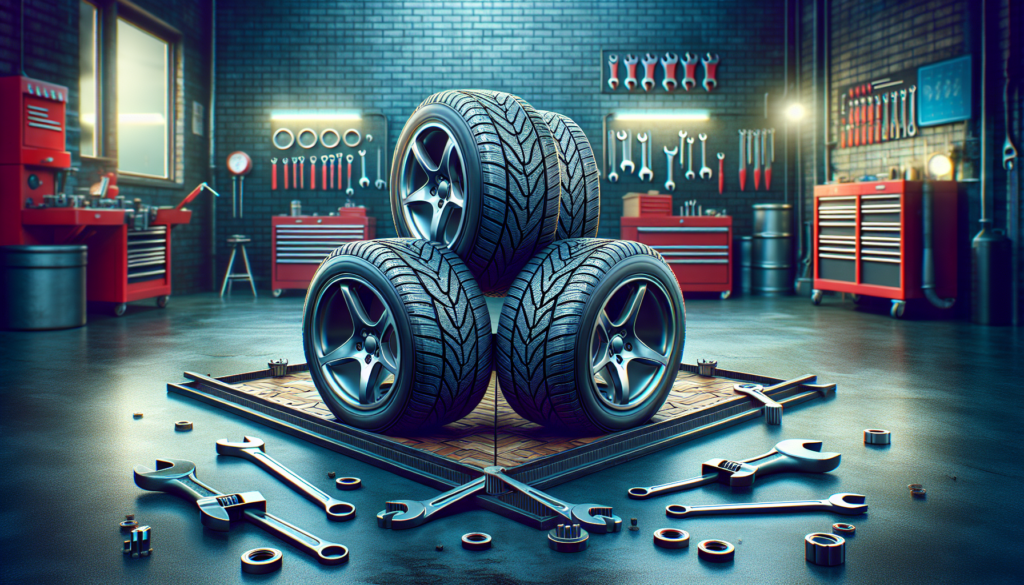You love cruising down the open road, but one thing that can put a damper on your smooth ride is misaligned wheels. It’s frustrating when your car veers to one side or there’s vibrations in the steering wheel. Luckily, there are simple steps you can take to protect your wheels from misalignment. Regularly checking your tire pressure, ensuring proper tire rotation, and getting periodic wheel alignments are all key in maintaining the straight trajectory you desire. By taking these preventive measures, you’ll not only enjoy a smoother driving experience, but also extend the lifespan of your tires and save on unnecessary repair costs. So, let’s explore some valuable tips to keep your wheels perfectly aligned and your journeys hassle-free.

Regular Wheel Maintenance
Check Tire Pressure Regularly
One of the most important aspects of regular wheel maintenance is checking the tire pressure regularly. Proper tire pressure not only ensures a smooth and comfortable ride, but it also helps in preventing wheel misalignment. When tires are improperly inflated, it puts unnecessary stress on the wheels, making them more susceptible to misalignment. By checking tire pressure regularly and maintaining the manufacturer’s recommended levels, you can significantly reduce the risk of misalignment.
Rotate Tires
Regularly rotating your tires is another essential maintenance task that can help prevent wheel misalignment. Tire rotation involves moving the tires from one position to another, typically from front to back or side to side. This process ensures that the tires wear evenly and reduces the strain on specific areas of the wheels. By promoting even wear, tire rotation minimizes the chances of uneven alignment and prolongs the lifespan of your wheels.
Balancing Tires
Properly balanced tires are crucial for maintaining wheel alignment. When your tires are out of balance, the weight distribution around the wheel assembly is uneven, leading to vibrations and potential misalignment. To avoid this, it is important to have your tires professionally balanced regularly. Balancing the tires involves adding small weights to the wheel rim to counterbalance any inconsistencies. By ensuring proper tire balance, you can avoid unnecessary stress on your wheels, reducing the risk of misalignment.
Inspect Suspension Components
Regularly inspecting your suspension components is an important part of wheel maintenance. The suspension system plays a crucial role in maintaining proper wheel alignment. Any worn-out or damaged suspension components, such as control arms, bushings, or struts, can lead to misalignment. By visually inspecting these components for any signs of deterioration or damage, you can catch potential issues early on and address them before they cause misalignment. It is recommended to consult with a professional mechanic or take your vehicle to a trusted service center for a thorough inspection.
Avoid Driving Over Potholes and Bumps
Slow Down and Be Cautious
One of the most effective ways to protect your wheels from misalignment is by avoiding driving over potholes and bumps whenever possible. Potholes and bumps can cause significant damage to the wheels, leading to misalignment and other issues. To minimize the risk, it is important to slow down and be cautious when encountering such road conditions. By reducing your speed and navigating around potholes and bumps carefully, you can protect your wheels from unnecessary impact and potential misalignment.
Maintain Proper Distance
Maintaining a proper distance between your vehicle and the vehicle in front of you is another important practice to avoid misalignment. When you are driving too closely, you have less time to react to sudden road obstacles, such as potholes or speed bumps. This increases the chances of hitting them directly, causing damage to your wheels. By keeping a safe distance, you can better anticipate and avoid such obstacles, reducing the risk of misalignment and other wheel-related issues.
Proper Driving Habits
Avoid Hitting Curbs
To protect your wheels from misalignment, it is crucial to avoid hitting curbs whenever possible. Hitting curbs can cause severe damage to the wheels, including bending or breaking them. Even a minor impact can result in misalignment and affect the overall performance of your vehicle. To prevent this, it is important to be mindful of your surroundings and practice careful and precise steering when approaching curbs. By avoiding direct contact with curbs, you can preserve the integrity of your wheels and minimize the risk of misalignment.
Drive Smoothly
Driving smoothly is not only important for a comfortable ride but also for the health of your wheels. Abrupt acceleration, sudden braking, and aggressive maneuvers put unnecessary stress on the wheels, leading to potential misalignment. By adopting a smooth driving style, you can reduce the strain on your wheels and maintain proper alignment. Gradually accelerating and decelerating, as well as implementing smooth steering movements, are key practices to ensure the longevity and alignment of your wheels.
Avoid Hard Cornering
While taking corners, it is essential to avoid hard cornering, as it can adversely affect the alignment of your wheels. Hard cornering involves taking a turn at high speeds or with excessive steering force. This places immense stress on the wheels, causing them to flex and potentially misalign. To protect your wheels, it is recommended to take corners at moderate speeds and apply gradual and controlled steering inputs. By practicing smooth and controlled cornering techniques, you can preserve the alignment of your wheels and enhance their overall longevity.
Avoid Overloading the Vehicle
Check Maximum Load Capacity
To prevent wheel misalignment, it is important to avoid overloading your vehicle. Each vehicle has a maximum load capacity specified by the manufacturer. Exceeding this capacity puts excessive strain on the wheels and suspension system, potentially leading to misalignment. To protect your wheels, it is essential to be aware of your vehicle’s maximum load capacity and ensure that you do not exceed it. By distributing the weight evenly and avoiding overloading your vehicle, you can maintain proper wheel alignment and optimize the performance of your vehicle.
Properly Distribute Weight
In addition to checking the maximum load capacity, it is crucial to properly distribute the weight within your vehicle. Uneven weight distribution can result in imbalanced loading, causing the wheels to bear excessive weight on certain sides. This imbalance can lead to uneven wear and misalignment. To prevent this, make sure to distribute the weight evenly throughout the vehicle, especially when carrying heavy items or loads. By properly balancing the weight, you can safeguard your wheels from misalignment and maintain optimal performance.

Wheel Alignment Check-ups
Schedule Regular Wheel Alignment
Regular wheel alignment check-ups are essential for maintaining the proper alignment of your wheels. Over time, the wheels can gradually shift out of alignment due to various factors such as road conditions, driving habits, or normal wear and tear. By scheduling regular wheel alignment appointments with a trusted service center, you can ensure that any misalignment is detected and corrected promptly. Regular alignment check-ups help prolong the lifespan of your wheels, enhance vehicle performance, and prevent more severe issues associated with misalignment.
Align Wheels After Significant Impact
In addition to regular check-ups, it is important to align your wheels after any significant impact or incident. Factors such as hitting a large pothole, curb, or being involved in a collision can cause severe misalignment. Even if the wheels appear visually intact, the impact may have shifted their alignment. To safeguard against any long-term damage or potential complications, it is crucial to have your wheels aligned by a professional mechanic after such incidents. By addressing misalignment promptly, you can protect your wheels and ensure the smooth operation of your vehicle.
Use High-Quality Wheels and Tires
Invest in Reliable Wheels
Investing in high-quality and reliable wheels is a proactive way to protect your wheels from misalignment. Cheap or low-quality wheels are more prone to damage and misalignment due to their inferior construction and materials. By investing in reputable and durable wheels, you can significantly reduce the risk of misalignment. Quality wheels are designed to withstand various road conditions and provide better resistance to impact and stress. When purchasing wheels, make sure to choose ones that are suitable for your vehicle and meet your specific needs.
Choose Tires with Good Tread
In addition to quality wheels, choosing tires with good tread is also important for protecting your wheels from misalignment. Tires with sufficient tread depth provide better traction and grip, improving the overall stability and handling of your vehicle. When tires have worn-out or uneven tread, it can lead to imbalanced weight distribution on the wheels, potentially causing misalignment. By regularly inspecting and replacing your tires when necessary, you can ensure that they have adequate tread depth. Good quality tires with proper tread can help minimize the risk of misalignment and enhance the safety and performance of your vehicle.

Avoid Modifying Suspension System
Consult with Professional Experts
When it comes to protecting your wheels from misalignment, it is crucial to avoid modifying the suspension system without proper consultation with professional experts. Modifying suspension components, such as installing aftermarket parts or making adjustments without the necessary knowledge and expertise, can negatively impact wheel alignment. Suspension modifications that are not in line with the Original Equipment Manufacturer (OEM) standards can lead to misalignment and compromise the overall performance and safety of your vehicle. Before making any modifications, it is highly recommended to consult with experienced professionals who specialize in suspension systems.
Consider OEM Standards
To maintain proper wheel alignment, it is advised to consider the OEM standards when servicing or modifying your suspension system. OEM standards refer to the specifications set by the vehicle manufacturer for the suspension components and their alignment. By adhering to these standards, you can ensure that the suspension system is properly calibrated and aligned with the manufacturer’s specifications. When it comes to wheel alignment, following the OEM standards minimizes the risk of misalignment and ensures the optimal handling, performance, and safety of your vehicle.
Proper Storage and Transportation
Use Wheel Racks or Stands
Proper storage and transportation of wheels are crucial for protecting them from misalignment. When wheels are not in use, it is recommended to store them upright on wheel racks or stands. This helps prevent unnecessary pressure on the wheels and avoids deforming or warping them over time. Storing wheels in a stacked or uneven manner can potentially affect their alignment. By using wheel racks or stands, you can maintain the integrity of your wheels and minimize the risk of misalignment when they are not in use.
Transport Wheels Safely
When transporting wheels, it is important to handle them with care to avoid misalignment. Whether you are changing tires or moving wheels to a different location, take precautions to secure them properly. Avoid dropping or roughly handling the wheels, as any impact can lead to misalignment. Use protective covers or blankets to prevent scratches or damage during transportation. Additionally, ensure that the wheels are securely fastened to avoid excessive movement that can cause misalignment. By following these guidelines, you can transport your wheels safely and protect them from unnecessary misalignment.

Conduct Regular Visual Inspection
Look for Signs of Misalignment
Regular visual inspections are vital for identifying any signs of misalignment in your wheels. Look for visible signs such as uneven tire wear, drifting to one side while driving, or vibrations in the steering wheel. Uneven tread wear patterns can indicate misalignment, as different parts of the tires are being subjected to varying levels of stress. It is crucial to address these signs promptly to prevent further misalignment and potential damage to the wheels. By conducting regular visual inspections, you can catch misalignment early and take the necessary steps to correct it, ensuring the longevity and performance of your wheels.
Check Tread Wear Patterns
In addition to signs of misalignment, paying attention to the tread wear patterns on your tires can provide valuable insights into the alignment of your wheels. Ideally, the tread wear should be even across the width of the tire. If you notice excessive wear on one side or in the center, it may indicate misalignment. Improper alignment can cause the tires to wear unevenly and decrease their lifespan. By regularly checking the tread wear patterns, you can identify any potential misalignment issues and take appropriate measures to correct them, protecting your wheels and ensuring optimal performance.
Seek Professional Help
Consult with Wheel Alignment Experts
When it comes to maintaining wheel alignment and protecting your wheels, seeking professional help is essential. Wheel alignment is a complex process that requires specialized equipment and expertise. Consulting with wheel alignment experts ensures that the alignment is performed accurately and according to the manufacturer’s specifications. These professionals have the knowledge and experience to diagnose and correct any misalignment issues effectively. By entrusting your vehicle to qualified experts, you can have peace of mind knowing that your wheels are in safe hands.
Get a Detailed Inspection
If you suspect any misalignment or are unsure about the condition of your wheels, it is recommended to get a detailed inspection performed by professionals. During a detailed inspection, the experts thoroughly examine your wheels, tires, suspension components, and other relevant aspects. They use advanced diagnostic tools and techniques to assess the alignment and identify any potential issues. A detailed inspection provides a comprehensive understanding of the condition of your wheels and helps determine the best course of action. By getting a detailed inspection, you can address any misalignment or related problems promptly, preventing further damage and ensuring the optimal performance of your wheels.
In conclusion, protecting your wheels from misalignment requires a combination of regular maintenance, safe driving habits, and professional assistance. By following the recommended practices outlined in this article, you can significantly reduce the risk of misalignment and prolong the lifespan of your wheels. Remember to prioritize checking tire pressure, rotating tires, balancing tires, inspecting suspension components, and avoiding driving over potholes and bumps. Additionally, practicing proper driving habits, avoiding overloading the vehicle, and conducting regular visual inspections are crucial. Investing in high-quality wheels and tires, avoiding suspension system modifications, and ensuring proper storage and transportation also contribute to protecting your wheels. Finally, seeking professional help through regular wheel alignment check-ups and detailed inspections is key to maintaining optimal alignment and preserving the health of your wheels. By implementing these measures, you can enjoy a smooth and safe driving experience while protecting your valuable wheels from misalignment.

